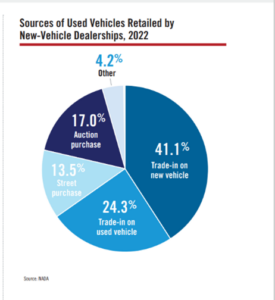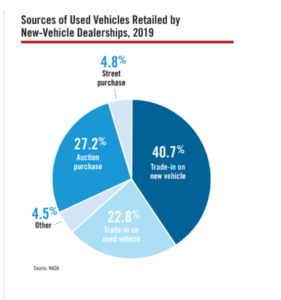It’s no secret that many dealers have been working hard to diversify how they source used vehicle inventory, relying less on trade-ins and auction purchases in favor of acquiring vehicles directly from consumers.
You can see the shift in the stats the National Automobile

Dealers Association publishes in its year-end report on dealer financials. In 2022, dealers told NADA they acquired about 66 percent of their used vehicles from trade-ins with new or used vehicle purchases. That’s up slightly from the tally in 2019, which landed near 63 percent (see charts at right).
But check out “street purchases.” These are vehicles dealers acquire through “we’ll buy your car” and similar programs. The stats affirm how much dealers have pursued direct-from-consumer vehicles in the past two years. Last year, street purchases represented 13.5 percent of the inventory dealers acquired, nearly tripling the 4.8 percent in 2019. (The gains likely came at the expense of auction purchases, which dropped 10 percent during the same period.)
Meanwhile, public used vehicle retailer CarMax has also

stepped up its efforts to acquire vehicles directly from customers. It’s always been a priority for CarMax, but it’s striking to note that in the first quarter of the company’s 2024 fiscal year, which ended June 30, direct-from-customer purchases accounted for 94 percent of the vehicles it acquired, almost double the percentage the company reported for its 2019 fiscal year.
I share all this to underscore how the used vehicle business now requires dealers to operate more effectively and proficiently across multiple sourcing channels. And, in my recent conversations with dealers, it’s clear that some dealers are doing a better job acquiring inventory profitably beyond trade-ins and auctions than others. I thought I’d highlight some of the best practices the top-performing operators employ to give them a sourcing advantage:
- Measure individual channel performance. It’s critical for dealers and used vehicle managers to have more than inkling about the number, type and profitability of vehicles they acquire from individual channels. These basic benchmarks help you know, as you’re mapping out your stocking plan and strategy for the coming month or quarter, where you can expect to find the cars, and fill the gaps, to meet your volume and profit goals. This holistic view of where inventory comes from, which you can see in ProfitTime GPS’ Global Acquisition Dashboard, provides the foundation for an effective sourcing strategy.
- Measure individual appraiser performance by channel. When dealers begin to assess how appraisers perform on a per-channel basis, you start to see some useful insights. First, most dealers immediately understand that, without oversight, individual appraisers and buyers often have their own means and methods for assessing a vehicle’s value. Such differences often lead to wide disparities in the Cost to Market and Look to Book percentages of how dealers bring in inventory. Against this backdrop, dealers are now making better-informed decisions about individual appraisers, coaching them on how they assess vehicles and determine the acquisition price and, in some cases, relieving them of their responsibility to appraise and purchase cars in a specific channel.
- Establish a “universal appraisal process and objective.” Once dealers and used vehicle managers realize that widespread variances among appraisers yields sub-optimal results, they’ll often begin work to ensure that, in any particular channel, appraisers have a uniform and universal process for assessing a vehicle’s condition and establishing its value. (Note: There’s often a direct correlation between the degree of appraisal variance and the use of default or standard reconditioning estimates, which can relieve appraisers of taking the time to fully account for the condition of the vehicle in front of them.) Next, dealers will establish a strategic objective that every appraiser, in any channel, can use as a starting point to bring in vehicles on the money. In ProfitTime GPS, for example, dealers use vehicle investment scores to establish the strategic objective, and then measure appraiser performance, across many appraisals, to understand how well individual appraisers bring in vehicles on or off strategy.
When I’ve outlined these best practices with dealers, I also make a point that I suspect has been a pillar of CarMax’s culture and operational priorities for a long time—if you’re not consistently measuring how right your appraisers are bringing in cars according to your strategy, you really don’t have a means to manage your way to improved performance.
The post 3 Best Practices for Today’s Multi-Channel Inventory Sourcing Environment appeared first on Dale Pollak.
















